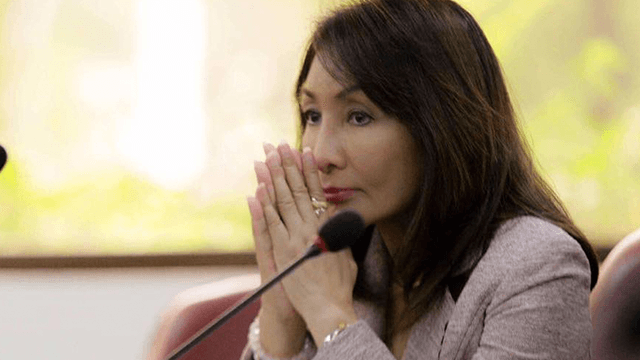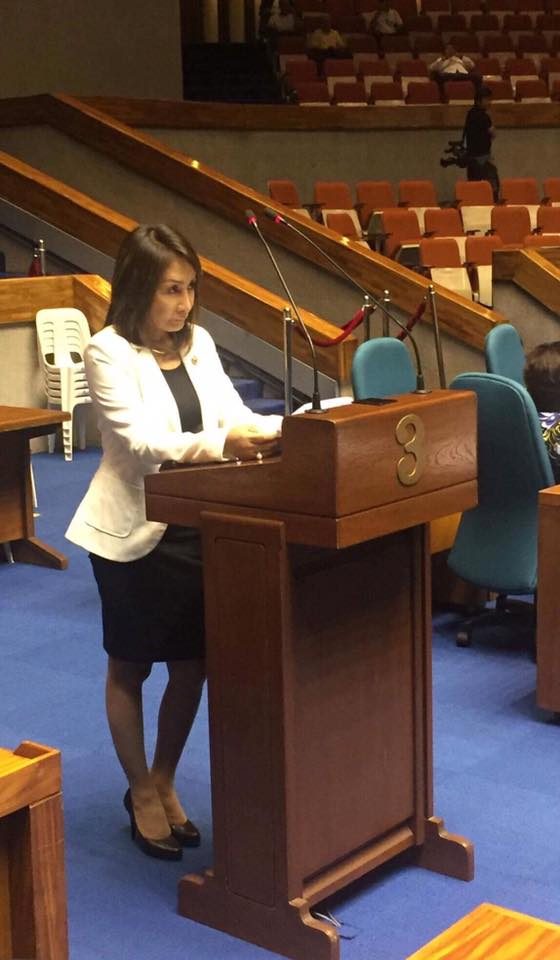SUMMARY
This is AI generated summarization, which may have errors. For context, always refer to the full article.

MANILA, Philippines – In the middle of asking questions during the House hearing on the impeachment complaint against Chief Justice Maria Lourdes Sereno on Monday, February 12, messages started to flood Deputy Speaker Gwendolyn Garcia’s cellphone.
They were messages from reporters covering the House, asking for her reaction to an Ombudsman order that dismissed her from her post and perpetually barred her from public office.
Her initial reaction: What Ombudsman decision?
She would find out later that the Office of the Ombudsman announced through a press release that it ordered the dismissal of Garcia for grave misconduct.
News outlets had mistakenly linked the order to the controversial purchase of the 24.9 hectare “Balili property” in Naga City, Cebu, by the provincial government, when she was still governor.
It isn’t.
The suspension stemmed from two later cases over the backfilling of parts of the property, filed by Garcia’s political rivals.
Garcia, who represents the 3rd district of Cebu in the House, has vowed to exhaust all legal means in the case. She has also publicly criticized the Ombudsman for its alleged “illegal encroachment” of Congress’ powers to discipline its own members and for the “questionable” timing of the decision.
The Balili case sheds light on the tangled web that is the local politics of vote-rich Cebu and the complications of a years-long dispute that persists to this day. (READ: Cebu and Garcia suspension: Whose battle is it?)
What is the property?
The Balili property is a 25-hectare beach front property in Barangay Tinaan of the province’s “industrial hub.” The property, purchased from the heirs of Luis Balili, cost roughly P98,926,800 and was intended as a dump for coal ash generated by a 200-MW coal-fired power plant operated by the Korean Electric Power Corporation (Kepco), according to a Bulatlat report from 2009.
The provincial government purchased it in 2008. A year later, however, the provincial government found out that a portion of one of the lots, totalling 89,124 square meters, was submerged in seawater. A portion of another lot, totalling around 14,401 square meters, meanwhile, turned out to be a mangrove area, according to a 2009 Freeman report posted on the Philippine Star.
As a result of the survey, the province demanded it be refunded for the money it spent buying those parcels of land. The province’s consultant, lawyer Rory Jon Sepulveda, explained then that the province relied on the lot titles.
They did not conduct a survey of the area prior to purchase, it turned out.
Apology, first legal battle
In 2009, Garcia apologized for the purchase while insisting the it was done in good faith, according to the same Bulatlat report.
Still, then senator John “Sonny” Osmeña called on the Office of the Ombudsman in the Visayas to probe the deal, saying Garcia’s apology should not absolve her from possible lapses. The senator, now mayor of Toledo city, belongs to a political clan that is a rival of the Garcias, another well-entrenched political clan. (READ: Can LP end the Garcia dynasty in Cebu?)

Cases of grave misconduct were eventually filed against Garcia. The first was filed by the Public Assistance and Corruption Prevention Office of the Office of the Deputy Ombudsman for the Visayas, based on an “anonymous complaint.”
Two other cases were filed by Manuel T. Manuel and Crisologo Saavedra.
In 2013 the Ombudman found Garcia and several others guilty of grave misconduct. When the decision was handed down in February 2013, Garcia was serving out a 6-month suspension order from the Office of the President over another case.
Despite the decision being moot and academic, Garcia filed a motion and was granted a reprieve by the Court of Appeals. In an April 2014 ruling, the CA in the Visayas nullified and set aside the Ombudsman’s findings.
Justices Gabriel Ingles, Ma. Lousi Quijano-Padilla, and Marie Christine Azcarraga-Jacob said the Ombudsman “acted whimsically, capriciously, and arbitrarily, amounting to lack of jurisdiction when it still proceeded to adjudicate the administrative cases against petitioner after her reelection.”
The CA was referring to the Aguinaldo doctrine, which was still in place then.
The doctrine clears officials of administrative sanctions if they are re-elected to the same post they held when the alleged infraction was committed. Criminal liabilities are not absolved, however.
Second Balili legal battle
While the first 3 cases were junked, Garcia faced another case. This time, it was over the backfilling of the property. This is the basis of the most recent order issued by Ombudsman Cochita Carpio Morales.
Back in 2013, then Deputy Ombudsman for the Visayas Pelagio Apostol said the probe into the controversial backfilling was almost over. The cases were filed by Garcia’s former ally, acting Cebu Governor Agnes Magpale and then Provincial Board Majority Floor Leader Arleigh Jay Sitoy.
Another complaint was filed by then gubernatorial candidate Hilario Davide III.
The complaints were based on the “discovery” that the portions that were submerged under water had been “reclaimed and covered with limestone and filling materials,” according to a Inquirer report.
Davide, who would go on to replace Garcia as governor, alleged the backfilling was done in bad faith since it would hide evidence for the criminal case Garcia was facing before the Sandiganbayan.
He also alleged that the P27 million used to “restore” the property would cause “tremendous damage and prejudice” to the province since the provincial board did not approve a budget for land conversion. He also alleged that no bidding was made.
The electoral battle
2013 was a particularly hot election year in Cebu province. Garcia was suspended in the last 6 months of her last term of governor, and was gunning to represent the 3rd district of the province in Congress.
Garcia’s brother was running for the gubernatorial post. Her father, himself a former governor and former deputy speaker, was running to represent the 2nd district of the province.

The Garcia clan then was allied with then-Vice President Jejomar Binay’s United Nationalist Alliance (UNA) and were going against the Liberal Party-affiliated local Bakud party, headed by Davide.
Garcia then described her suspension as a “power grab” over the vote-rich Cebu province.
Almost 5 years later, OmbudsmanMorales decided that Garcia was guilty of grave misconduct over the backfilling.
The controversy surround the property isn’t over yet.
Saavedra, “whistleblower” and complainant in the first case against Garcia, wants to file a complaint against Governor Davide should he push through with his plan to sell the property to the Naga City local government.
What now for Garcia?
Garcia, as deputy speaker, is one of the more vocal personalities in the House of Representatives.
She endorsed at least two impeachment complaints in 2017: the first, against then-Commission on Elections (Comelec) Chairman Andres Bautista; the other, against Chief Justice Sereno. (READ: ‘Reversal of fortunes’: Garcia, Roque celebrate Bautista impeachment)
Despite the complaint being rejected by the justice committee, Bautista was eventually impeached by the House through a plenary vote. The hearings on the Sereno impeachment case are ongoing and Gwen Garcia is among the most active in it.
The deputy speaker calls the Ombudsman’s decision an attempt to disrupt her active participation in the Sereno impeachment case and deliberations, as well as to an impeachment complaint against Morales herself.
Garcia is also questioning why it took the Ombudsman so long to make the decision.
While she’s yet to file appeals on the decision, Garcia is already invoking the Aguinaldo doctrine, which was in place at the time the complaints were filed. (READ: Only Congress can remove its members – Roque)
There’s an interesting difference, however, between the first Balili case over its purchase and the second one over the backfilling: Garcia was re-elected governor in 2010. But she was elected 3rd district representative in 2013.
It’s deja vu for Garcia, whose suspension began the year before the election and spanned the entire 2013 campaign period. (READ: Is it game over for Gwen Garcia after Ombudsman’s dismissal order?)
2018 also happens to be the year before the scheduled 2019 mid-term elections, during which Garcia is expected to gun for re-election.
Will she be able to ride out another controversy? – Rappler.com
Add a comment
How does this make you feel?
There are no comments yet. Add your comment to start the conversation.